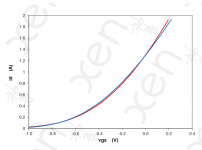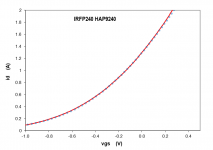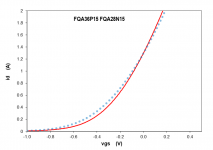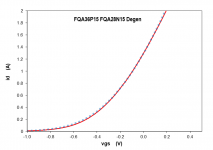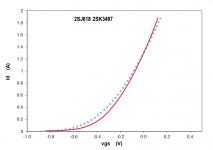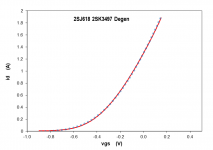The truely complementary pair of MOSFETs 2SK1530 / 2SJ201 is now unobtanium.
Even our own stock has been depleted.
The search for alternatives has not stopped, however.
We have previously had good experience with the Fairchild FQA9P25.
https://www.diyaudio.com/forums/solid-state/343164-udness-dont-semisouths.html
So we have been looking for some time for a compatible N device.
https://www.diyaudio.com/forums/pass-labs/369546-f5-2sk1530-2sj201-post6577901.html
Finally I got one sample of each and curve traced them.
Here is the result.
The NMOS has a Vgs pf 5.5V at 1.3A, and a Yfs of 3S.
The PMOS has a Vgs of 5.2V at 1.3A, and a Yfs of 2.7S.
In the graph below, the Vgs is manually aligned to 0V at 1.3A for ease of comparison.
As this is only one single sample, it is difficult to tell whether the difference is statistical or systematic.
But there is a reasonable chance that even better NP match can be found in a larger batch.
Patrick
.
Even our own stock has been depleted.
The search for alternatives has not stopped, however.
We have previously had good experience with the Fairchild FQA9P25.
https://www.diyaudio.com/forums/solid-state/343164-udness-dont-semisouths.html
So we have been looking for some time for a compatible N device.
https://www.diyaudio.com/forums/pass-labs/369546-f5-2sk1530-2sj201-post6577901.html
Finally I got one sample of each and curve traced them.
Here is the result.
The NMOS has a Vgs pf 5.5V at 1.3A, and a Yfs of 3S.
The PMOS has a Vgs of 5.2V at 1.3A, and a Yfs of 2.7S.
In the graph below, the Vgs is manually aligned to 0V at 1.3A for ease of comparison.
As this is only one single sample, it is difficult to tell whether the difference is statistical or systematic.
But there is a reasonable chance that even better NP match can be found in a larger batch.
Patrick
.
Attachments
How do they compare with IRFP240/9240 ?
Ignore the well-known problem of the IRF PMOS for now.
The values listed below are Device Type / Vgs at 1.3A / Yfs at 1.3A / Ciss / Coss / Crss.
Units are Volt / Siemens / pF / pF / pF.
IRFP240 / 4.50 / 3.20 / 1300 / 400 / 130
FQA10N80C-F109 / 5.50 / 3.00 / 2150 / 180 / 15
IRFP9240 / 4.00 / 3.00 / 1200 / 370 / 81
FQA12P20 / 5.52 / 2.70 / 920 / 190 / 30
These values vary typically ~10% for Vgs and 30%for Yfs.
PassDiy
N-P Vgs difference can be anything betwwen 0.1V to 0.5V for the IRFP's.
And not only between devices, but also between batches.
i.e. there is no perfect N-P match on average between the IRFP's
For a circuit like the F5, the ~10% lower transconductance is more than compensated by the ~20% higher bias voltage.
The FQA NMOS does have a much higher Ciss, so a high-Idss frontend is desirable.
For a circuit like the F4 or M2, only the Crss is important.
The FQAs are a clear winner there.
The difference in transconductance to the IRFPs is equivalent to 0.01R.
If it should ever bother you, you can simply reduce the source resistor by the same amount.
Patrick
Ignore the well-known problem of the IRF PMOS for now.
The values listed below are Device Type / Vgs at 1.3A / Yfs at 1.3A / Ciss / Coss / Crss.
Units are Volt / Siemens / pF / pF / pF.
IRFP240 / 4.50 / 3.20 / 1300 / 400 / 130
FQA10N80C-F109 / 5.50 / 3.00 / 2150 / 180 / 15
IRFP9240 / 4.00 / 3.00 / 1200 / 370 / 81
FQA12P20 / 5.52 / 2.70 / 920 / 190 / 30
These values vary typically ~10% for Vgs and 30%for Yfs.
PassDiy
N-P Vgs difference can be anything betwwen 0.1V to 0.5V for the IRFP's.
And not only between devices, but also between batches.
i.e. there is no perfect N-P match on average between the IRFP's
For a circuit like the F5, the ~10% lower transconductance is more than compensated by the ~20% higher bias voltage.
The FQA NMOS does have a much higher Ciss, so a high-Idss frontend is desirable.
For a circuit like the F4 or M2, only the Crss is important.
The FQAs are a clear winner there.
The difference in transconductance to the IRFPs is equivalent to 0.01R.
If it should ever bother you, you can simply reduce the source resistor by the same amount.
Patrick
This is how well they match if a 0.03R resistor is added to the source of the NMOS.
Of course this is well within the variations of Yfs in a large batch.
That means the chances are that you can find N-P match also in Yfs without this R_source trick.
Patrick
.
Of course this is well within the variations of Yfs in a large batch.
That means the chances are that you can find N-P match also in Yfs without this R_source trick.
Patrick
.
Attachments
This is interesting. Perhaps a better comparison for the P-type device would be the IRFP9140. That is what I have paired with the IRFP240 in my M2x.
Fair enough.
The next question is, does the higher threshold voltage of the FQA devices require some adjustment to work correctly in the M2 output stage?
BTW: I have already made an FQH44N10 substitution for the output devices in my F6. That worked brilliantly.
The next question is, does the higher threshold voltage of the FQA devices require some adjustment to work correctly in the M2 output stage?
BTW: I have already made an FQH44N10 substitution for the output devices in my F6. That worked brilliantly.
Last edited:
Thanks. I will keep the output devices in my M2x for now. It is being rebuilt into a pair of dual-mono chassis, so I need to listen to that version first.
This is how well they match if a 0.03R resistor is added to the source of the NMOS.
Of course this is well within the variations of Yfs in a large batch.
That means the chances are that you can find N-P match also in Yfs without this R_source trick.
I pulled the R-source trick in the production version of the ACA mini -
while I'm looking for a generally 2nd harmonic character to the
IRF520 and IRF9520, I put a jumper in to RC bypass the P channel
source resistor and take the 2nd down by 70% or so. People can
pop the jumper in and out while they listen...
And those are the Harris parts.....

This one I think a lot of people are looking for -- IRFP240 vs Harris 9240.
Almost perfect curve match (you still need to match Vgs).
Red line is NMOS.
You can still get Harris from Rochester, while stock lasts :
Rochester Electronics (en-US)
: Part IRFP9240
MoQ 84 pieces.
More measurements to come. Watch this space.
Patrick
.
Almost perfect curve match (you still need to match Vgs).
Red line is NMOS.
You can still get Harris from Rochester, while stock lasts :
Rochester Electronics (en-US)
: Part IRFP9240
MoQ 84 pieces.
More measurements to come. Watch this space.
Patrick
.
Attachments
The IRFP240 is from a recent batch at Mouser.
And the exact values are as follows (at 1.3A bias) :
IRFP240 Vgs 4.73V Yfs 2.33S
HA9240 Vgs 4.48V Yfs 2.36S
About 15% less Yfs than the FQA pair in post #1.
Patrick
And the exact values are as follows (at 1.3A bias) :
IRFP240 Vgs 4.73V Yfs 2.33S
HA9240 Vgs 4.48V Yfs 2.36S
About 15% less Yfs than the FQA pair in post #1.
Patrick
Next on the queue -- FQA36P15 / FQA28N15, as used in Accuphase power amps.
That is after they were forced to switch ti Fairchild.
Degen is 0.04R on NMOS when applicable.
Yfs at 1.3A = 3.37S & 3.79S (raw).
Patrick
.
That is after they were forced to switch ti Fairchild.
Degen is 0.04R on NMOS when applicable.
Yfs at 1.3A = 3.37S & 3.79S (raw).
Patrick
.
Attachments
Last but not least, 2SJ618 / 2SK3497 as used in Accuphase power amps before switching to Fairchild.
Simply because the Toshibas became obsolete.
Degen is 0.05R on NMOS when applicable.
Yfs at 1.3A = 3.75S & 4.43S (raw).
Highest of all. Also much lower Vgs at ~2.4V.
Patrick
.
Simply because the Toshibas became obsolete.
Degen is 0.05R on NMOS when applicable.
Yfs at 1.3A = 3.75S & 4.43S (raw).
Highest of all. Also much lower Vgs at ~2.4V.
Patrick
.
Attachments
N
No degen on PMOS? Isn't input capacitance on FQA36P15 almost double of that FQA28N15?
Next on the queue -- FQA36P15 / FQA28N15, as used in Accuphase power amps.
That is after they were forced to switch ti Fairchild.
Degen is 0.04R on NMOS when applicable.
Yfs at 1.3A = 3.37S & 3.79S (raw).
Patrick
.
No degen on PMOS? Isn't input capacitance on FQA36P15 almost double of that FQA28N15?
- Home
- Amplifiers
- Pass Labs
- Complementary Power MOSFETs
